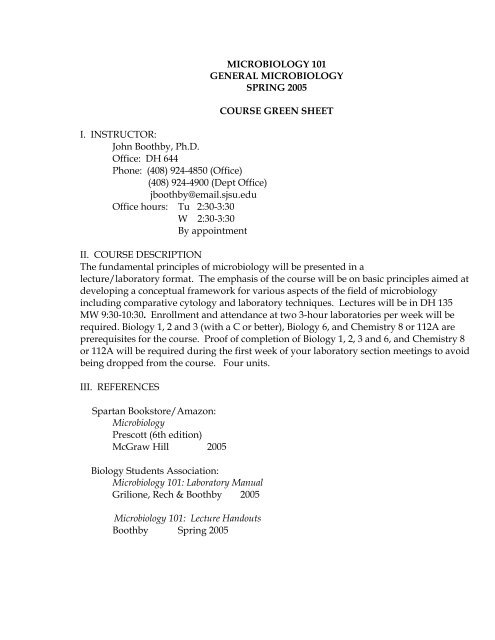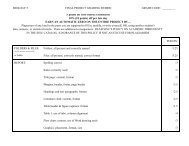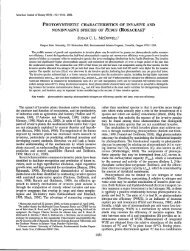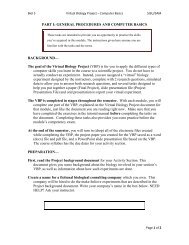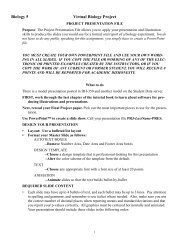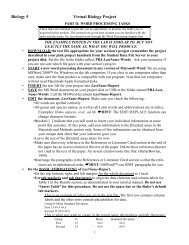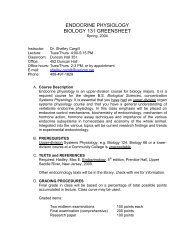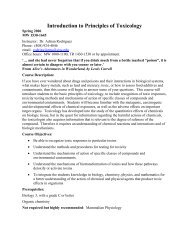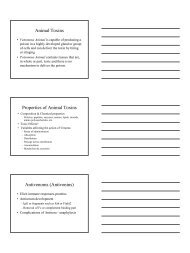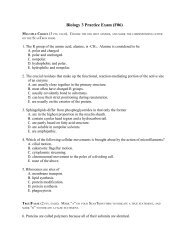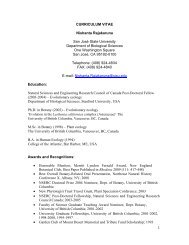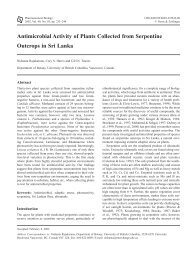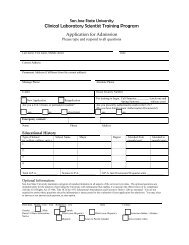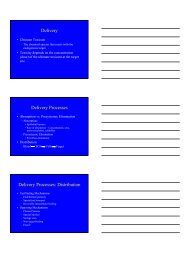Micro 101, Lecture Greensheet - sp05 (pdf)
Micro 101, Lecture Greensheet - sp05 (pdf)
Micro 101, Lecture Greensheet - sp05 (pdf)
You also want an ePaper? Increase the reach of your titles
YUMPU automatically turns print PDFs into web optimized ePapers that Google loves.
I. INSTRUCTOR:<br />
John Boothby, Ph.D.<br />
Office: DH 644<br />
Phone: (408) 924-4850 (Office)<br />
(408) 924-4900 (Dept Office)<br />
jboothby@email.sjsu.edu<br />
Office hours: Tu 2:30-3:30<br />
W 2:30-3:30<br />
By appointment<br />
MICROBIOLOGY <strong>101</strong><br />
GENERAL MICROBIOLOGY<br />
SPRING 2005<br />
COURSE GREEN SHEET<br />
II. COURSE DESCRIPTION<br />
The fundamental principles of microbiology will be presented in a<br />
lecture/laboratory format. The emphasis of the course will be on basic principles aimed at<br />
developing a conceptual framework for various aspects of the field of microbiology<br />
including comparative cytology and laboratory techniques. <strong>Lecture</strong>s will be in DH 135<br />
MW 9:30-10:30. Enrollment and attendance at two 3-hour laboratories per week will be<br />
required. Biology 1, 2 and 3 (with a C or better), Biology 6, and Chemistry 8 or 112A are<br />
prerequisites for the course. Proof of completion of Biology 1, 2, 3 and 6, and Chemistry 8<br />
or 112A will be required during the first week of your laboratory section meetings to avoid<br />
being dropped from the course. Four units.<br />
III. REFERENCES<br />
Spartan Bookstore/Amazon:<br />
<strong>Micro</strong>biology<br />
Prescott (6th edition)<br />
McGraw Hill 2005<br />
Biology Students Association:<br />
<strong>Micro</strong>biology <strong>101</strong>: Laboratory Manual<br />
Grilione, Rech & Boothby 2005<br />
<strong>Micro</strong>biology <strong>101</strong>: <strong>Lecture</strong> Handouts<br />
Boothby Spring 2005
IV. EXAMINATIONS AND GRADES<br />
<strong>Lecture</strong>: There will be 3 examinations for the lecture portion of the course. All<br />
examinations will be comprehensive although topics under current discussion<br />
will be emphasized. The material covered on examinations may be from<br />
lecture, from the required texts, from laboratory exercises/discussions, and from<br />
any outside reading.<br />
Examinations will be graded and returned for review during the laboratory<br />
period within 10 days. All examinations will be retained by the instructor, but<br />
will be available for review during office hours or by appointment. All<br />
materials will be discarded 30 days after the end of the semester. No late<br />
examinations will be accepted without advance consent of the instructor.<br />
Makeup examinations for those obtaining advanced consent may be oral or<br />
written at the discretion of the instructor. Any examination may be submitted<br />
for regrading, if incorrectly scored, at the request of the student within 1 week of<br />
their return for review. No changes in test scores will be made after that time.<br />
A SCANTRON FORM 886 will be required for each examination. Scores from<br />
each examination will be weighted (see below) in computing the<br />
lecture letter grade.<br />
EVALUATION WEIGHT DATE TIME .<br />
Exam I 25% W (3/23) 9:30-10:20<br />
Exam II 35% W (4/27) 9:30-10:20<br />
Exam III (Final) 40% Tu (5/24) 7:15-9:30<br />
Laboratory Grade: Laboratory instructors will determine the letter grade for the<br />
laboratory portion of the course. Each instructor will explain their grading<br />
criteria during the first meeting of each laboratory section.<br />
Final Course Grade: Letter grades from the lecture (50%) and the laboratory (50 %)<br />
portions of the course will be used to determine a course letter grade.<br />
V. DROPS:<br />
University and Department guidelines require a serious and compelling reason to drop a<br />
course. Grades, alone, do not constitute reason to drop a course.<br />
VI. LAB FEE<br />
A lab fee is charged for this class at the time of registration.
MICROBIOLOGY <strong>101</strong><br />
LECTURE TOPICS OUTLINE<br />
SPRING 2005<br />
LECT # TOPICS COVERED TENTATIVE REFERENCE READING<br />
DATE<br />
(Prescott 6th edition)<br />
1 <strong>Greensheet</strong> W (1/25) ----<br />
Course organization<br />
2 Discovery of microbes M (1/31) Chapt 1<br />
3 <strong>Micro</strong>scopy & Flow Cytometry W (2/2) Chapt 2<br />
Cell size/scales (µm,mm,cm)<br />
4 Investigation of <strong>Micro</strong>bes M (2/7) Chapt 1<br />
Pasteur & Koch<br />
5 Cultivation of microbes W (2/9) Chapt 5<br />
<strong>Micro</strong>bial media<br />
6 Assimilatory metabolism M (2/14) Chapt 8<br />
7 Dissimilatory metabolism W (2/16) Chapt 9/28<br />
Nutritional classification of microbes<br />
8 <strong>Micro</strong>bial Classification M (2/21) Chapt 19<br />
Kingdoms & Domains<br />
Dichotomous key<br />
9 Symbiosis Terms & Concepts W (2/23) Chapt 28/34/37<br />
<strong>Micro</strong>bial Culture & Enrichement<br />
10 Protista I M (2/28) Chapt 4<br />
Kingdom organization/cell structure<br />
11 Protista II W (3/2) Chapt 26<br />
Algae<br />
12 Protista III M (3/7) Chapt 27/40<br />
Protozoa<br />
13 Fungi I W (3/9) Chapt 25<br />
Kingdom organization/cell structure
14 Fungi II M (3/14) Chapt 25<br />
Lower fungi<br />
15 Fungi III W (3/16) Chapt 25/40<br />
Higher fungi<br />
16 Procaryotae I M (3/21) Chapt 3/10<br />
Kingdom organization<br />
/cell structure/recombination<br />
Elemental cycles<br />
18 Exam I W (3/23) --<br />
-- Spring Recess (3/28--4/1)<br />
19 Procaryotae II M (4/4) Chapt 7<br />
Antimicrobials<br />
20 Procaryotae III W (4/6) Chapt 6<br />
Bacterial quantification<br />
Growth curves/generation time<br />
21 Eubacteria I M (4/11) Chapt 21-24<br />
Photosynthetic bacteria<br />
Giding Bacteria<br />
Prosthecate bacteria<br />
Spirochetes<br />
Spirilla<br />
22 Eubacteria II W (4/13) Chapt 21-24<br />
Vibrios<br />
Pseudomonads<br />
Acetic acid bacteria<br />
Enterics, etc.<br />
23 Eubacteria III M (4/18) Chapt 21-24<br />
Sporeformers<br />
<strong>Micro</strong>cocci/Staphlococci
24 Eubacteria IV W (4/20) Chapt 21-24<br />
Lactic acid bacteria<br />
Actinomycete line<br />
25 Eubacteria V M (4/25) Chapt 21-24/39<br />
Chlamydias/Rickettsias<br />
Mycooplasmas<br />
26 Exam II W (4/27) --<br />
27 Archaebacteria M (5/2) Chapt 20<br />
Characterization of group<br />
Methanogenic archaebacteria<br />
Extremophilic archaebacteria<br />
28 Viruses I W (5/4) Chapt 16-18<br />
Characterization of group<br />
29 Viruses II M (5/9) Chapt 16-18<br />
Hosts/replication cycles<br />
30 Celled microbes/ W (5/11) Chapt 16-18/38<br />
Viruses/viroids/prions<br />
31 Host resistance I M (5/16) Chapt 31-33<br />
Innate mechanisms<br />
Aquired mechanisms<br />
Immunopathology<br />
--- Final Exam Tuesday (5/24)<br />
7:15-9:30 AM


